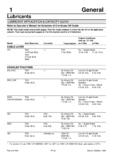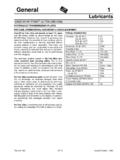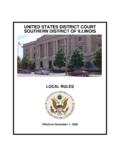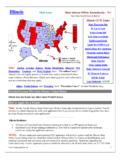Transcription of General 1
1 General 1. Lubricants Table of Contents Bartender II Lubricating System .. 1E-29 to 1E-30 Lubricating Equipment: Engine Oils: Grease Guns And Accessories .. 1E-32 to 1E-38. Case IH No. 1 .. 1E-7 to 1E-8 Funnel Cap .. 1E-39. Case IH Low Ash .. 1E-9 to 1E-10 Free-Flo Spout .. 1E-39. Auto Supreme .. 1E-11 Grease Fittings .. 1E-40 to 1E-43. Hydraulic/Transmission Fluids: Systemgard Lubricant Analysis Service .. 1E-44. Case IH Hy-Tran Ultra .. 1E-12 to 1E-13 Part Number Index .. 1E-184 to 1E-185. Low Temperature Hy-Tran Ultra .. 1E-14 Sun 2 Waste Oil Heater .. 1E-45 to 1E-47. Case Hydraulic Excavator Fluid .. 1E-15 Oil Story .. 1E-2 to 1E-6. Case AW Hydraulic Fluid .. 1E-16 Specialty Fluids/Lubricants: Case TCH Fluid .. 1E-17 Case IH 135H EP Gear Lube .. 1E-20. Case Trans-XHD Fluid .. 1E-16 Case IH Limited Slip Additive .. 1E-21. Case Transaxle Fluid .. 1E-18 Case Brake Rebuild Additive .. 1E-21. Case HTO/HTO Premix Fluid .. 1E-19 Case Crawler Brake Oil .. 1E-22. Lube Minder Automatic Case IH Slip Plate No.
2 1 and 3. Chain Lubrication System .. 1E-31 Graphite Lubricant .. 1E-23. Lubricant Application & Capacity Guide: Case IH Seed Flow Lubricant .. 1E-22. Case and Case IH Tractors .. 1E-50 to 1E-97 AG Lubricant .. 1E-23. IH Tractors .. 1E-98 to 1E-127 Molykote G-n Lubricant .. 1E-24. Steiger Tractors .. 1E-128 to 1E-149 EP-O Grease .. 1E-24. Equipment/IH and Case IH .. 1E-150 to 1E-179 Ultra Blue Hi-Temp Grease .. 1E-24. Irrigation Power Units .. 1E-148 to 1E-149 Case IH 251H-EP Grease .. 1E-25. Uni-Loader Skid Steers .. 1E-180 to 1E-182 Moly Multi-Purpose Grease .. 1E-26. Crankcase Lubricants .. 1E-183 Case IH Cotton Picker Bar Lube .. 1E-26. Spindle Grease .. 1E-27. Case IH Spindle Cleaner .. 1E-28. Viscosity Equivalents .. 1E-48. Viscosity - Temperature Usage Recommendation .. 1E-49. 1999 Case Corporation Rac 8-61485 1E-1 Issued October, 1999. 1 General Lubricants THE OIL STORY. WHAT IS OIL? WHAT OILS DO. Engine oils and transmission/hydraulic fluids are carefully Lubricating oils are expected to perform an assortment selected combinations of base stocks and additives which of tasks to keep your equipment running smoothly.
3 Are blended to give desired performance in a wide variety of applications. Lubrication is the first and foremost task. To do this, oils form a thin fluid film on moving parts, preventing the Base Stocks are refined from crude oil to obtain prod- metal to metal contact which would cause excessive ucts with the best lubricating properties. Base stocks wear or failure of an engine or transmission. generally make up 80-95% of a typical engine oil. Cooling is provided by the circulating oil which carries Additives are chemicals added to the base stocks to heat away from moving parts to minimize oxidation and improve performance. While representing only 20% or deposit formation. less of the material in engine oils and hydraulic fluids, the proper additives are critical to obtain optimum lubricating Dispersion of Contaminants is achieved by special performance in today's equipment. There are a number additives which surround some contaminants keeping of additives used in oil. The most common are viscosity them in solution within the oil.
4 These special additives index improvers, detergents, dispersants, anti-wear and insure that particles are transported to the filter where friction modifiers, oxidation and corrosion inhibitors, acid they can be removed from the oil. Particle disbursement neutralizers, pour point depressants, and anti-foam prevents the formation of deposits on metal surfaces in agents. By properly blending combinations of these addi- the engine and also prevents corresponding engine tives, oil manufacturers can tailor products to meet the wear. specific needs of their customers. Oxidation Resistance is important in extending the Multigrade Engine Oils exhibit behavior at low temper- service life of an oil. Oil reacts with oxygen at high tem- atures for easier starting and thick oil characteristics at peratures in engines to form gums and varnish which operating temperatures for better wear resistance and cause deposits and thickening of the oil. When added to sealing. The addition of special polymers to the base oil, oxidation inhibitors reduce sludge formation and sig- oils allows for this versatility.
5 These polymers expand as nificantly increase the oil's useful life. temperature increases, resulting in a thicker oil. One big drawback in the use of multigrade oils is that the poly- Corrosion Protection is necessary to combat chemical mers shear, or break down under load. As a result, with attack on engines. Detergents and acid neutralizers are time of service in heavy-duty applications, performance added to oil to clean engines of harmful deposits and to is reduced. Polymer shearing also can contribute to car- counteract the strong acids which are formed in an bon deposit formation in diesel engines. Hydrostatic engine during combustion. transmissions are even more sensitive to polymer shear The way an oil is used has important effects on the type than engines. of oil required. Available Horsepower Used in an engine ranges from 30% in a car or pick-up truck to 60% in an over-the-road truck, and up to 90% in a farm tractor or piece of con- struction equipment. Oils for your tractor, therefore, need to be formulated differently than oil for your car due to the vastly different severity of service.
6 Rac 8-61485 1E-2 Issued October, 1999. General 1. Lubricants THE OIL STORY. WHAT SHOULD I LOOK FOR IN AN OIL? Sulfated Ash content is an indication of the amount of Not all oils are the same. The only way to distinguish additives in the oil for detergency, dispersion and acid them is by comparing data sheets and analyzing the neutralization. In a gasoline engine a lower ash content areas listed in the Typical Properties Table (shown on is preferable because it minimizes spark plug and valve bottom of page). deposits, and acid is less of a problem than in diesel engines. In most diesel engines, a high ash content is Viscosity is a measure of an oil's resistance to flow. In desirable for improved varnish control and acid neutral- practical terms, viscosity is the property which governs ization. Case No. 1 oil has an ash content of , oil thickness in an engine. If oil has too low a viscosity while typical universal oils have ash contents of about (is too thin) there will be increased oil consumption, oil 1%.
7 Leakage, engine noise, friction and wear. On the other hand, if the viscosity is too high (too thick an oil) there Viscosity Index (VI) is a measure of the rate of change will be problems with starting, increased fuel consump- in viscosity at different temperatures. For an engine oil, tion, reduced power output and impaired engine cool- a VI of 95 or higher for a straight grade product indicates ing. a quality base stock. A VI above 115 indicates a multi- grade oil which contains a polymer to increase viscosity Zinc content is a measure of the amount of zinc dithio- index for an all seasons oil. phosphate, an anti-wear additive, in the oil. No. 1 is for- mulated with 100% high thermal stability zinc Cold Crank, borderline pumping temperature, and pour dithiophosphate, which is less susceptible to chemical point all relate to the ability of an oil to lubricate during breakdown than the zinc additives typically used in gas- the critical cold start period. The first few minutes can oline engine oils.
8 All universal diesel/gasoline engine cause more wear than several hours of heavily loaded oils (API CF-4 or CE and SF or SG) contain low ther- operation. The lower the numbers the better. mally stable zinc additive. Case IH engineering has determined that high thermally stable zinc is more effec- Total Base Number (TBN) is an indication of the acid tive in diesel engines. This change has enabled us to neutralizing capability of an oil. This is especially impor- use slightly lower levels of zinc than in the past, and tant in diesel engines where the sulfur content of the actually improved diesel engine performance. fuel can lead to sulfuric acid corrosion. The higher the TBN, the more protection against acid. As a rule of thumb, TBN should be at least 20 times the sulfur con- tent of the fuel. TYPICAL PROPERTIES. SAE 10W SAE 10W-30 SAE 30 SAE 15W-40. API Service Class CD CF-4, CD CE, CDII CF-4, CE, CDII. Viscosity: cSt, @ 40 C 42 70 108 99. cSt, @ 100 C SUS, @ 100 F 217 358 565 505.
9 SUS, @ 210 F 49 67 69 80. Zinc, % Sulfated Ash,% Viscosity Index 110 160 100 160. Pour Point, F -37 (-35) -35 (-31) -26 (-15) -29 (-20). Total Base No. (ASTMD-2896) Cold Crank, cP @ C ( F) 2900 @ -20 C 3100 @ -20 C 3100 @ -15 C. Borderline Pumping Temperature -33 (-27) -33 (-27) -20 (-4) -29 (-20). C ( F). Flash Point, C ( F) 210 (410) 210 (410) 224 (435) 220 (428). API Gravity Rac 8-61485 1E-3 Issued October, 1999. 1 General Lubricants THE OIL STORY. Each lubricant needs to perform different functions and is blended to specifications designed to protect and enhance different systems. Transmission/Hydraulic Fluids lubricate, protect, IMPORTANT: When it comes to lubricants, we suggest transfer heat and serve as a power transmission you know these definitions: medium for hydraulic and transmission systems. Typical anti-wear (AW) hydraulic oils are designed to meet Approved - This is the highest level of endorsement. It industrial hydraulic applications in indoor (temperature means the oil being described has been tested and and humidity controlled) environments.
10 They are not approved for use by the military or OEM named. This transmission fluids. indicates the oil has undergone a long, exhaustive series of performance tests and has convinced the Case IH designs its hydraulic/transmission fluids to be approving organization that it will perform satisfactorily used in all-season outdoor environments, torque con- in actual field service. verters, and high pressure hydraulic applications. Case IH fluids contain more anti-wear additive and have Meets - This designation is a statement that, in the oil far better water tolerance than typical AW hydraulic oils. company's opinion, the product meets the specifications named. It does not mean the oil has been tested and Engine Oils lubricate, cool, help clean and provide cor- approved by the military or OEM whose specifications rosion protection for engines. Typical oils are designed are being cited. for use in cars and trucks. Case IH specially blends its premium engine oils for the severe service demands of Recommended - The recommendation is being made heavy-duty off-road equipment.








